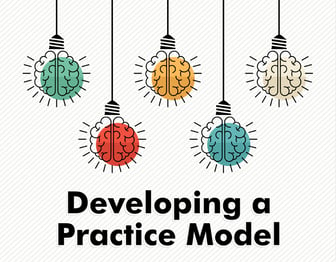This blog is a continuation of the EBP Practice Models blog series started by this blog’s author Evan C. Crist, Psy.D. and other industry leading authorities on practice models, Brad Bogue, Matt Moore and Tom O’Connor.
 When Brad Bogue first suggested we work on a “practice model” I was embarrassed to admit I had no idea what he was talking about. After a bit of research I realized that, while the term was foreign to me, the concept was not that complicated and was a logical extension of our agency’s evidence-based practices (EBP) training. I learned that practice models structure the use of various EBPs into a logical, coherent process to help practitioners identify the next necessary step in the intervention sequence.
When Brad Bogue first suggested we work on a “practice model” I was embarrassed to admit I had no idea what he was talking about. After a bit of research I realized that, while the term was foreign to me, the concept was not that complicated and was a logical extension of our agency’s evidence-based practices (EBP) training. I learned that practice models structure the use of various EBPs into a logical, coherent process to help practitioners identify the next necessary step in the intervention sequence.
Armed with lots of knowledge about EBP, but without a framework to identify and organize what techniques to use when, we recognized we did, indeed, need a practice model. Since I am writing this blog during the Christmas season, it seemed that we had lots of ornaments and tinsel but no tree on which to hang them. It became clear that without a practice model we would remain knowledgeable about EBP but unskilled in their delivery.
I looked at several of the prepackaged practice models available .jpg?width=287&name=Practice-Models-(BB).jpg) but found all of them lacking. They were either incongruous with my clinical experience (e.g., the importance of building motivation was essentially ignored) or contradicted my philosophy of the change process (e.g., they followed a manual but left little room for situational flexibility). With Brad at my side challenging my assumptions every step of the way, we decided to develop a practice model in house. We facilitated the process while our capable staff of case managers merged research with their experience and theory with reality.
but found all of them lacking. They were either incongruous with my clinical experience (e.g., the importance of building motivation was essentially ignored) or contradicted my philosophy of the change process (e.g., they followed a manual but left little room for situational flexibility). With Brad at my side challenging my assumptions every step of the way, we decided to develop a practice model in house. We facilitated the process while our capable staff of case managers merged research with their experience and theory with reality.
It was a vital learning experience for me. I thought I needed to teach the case managers to think; turns out, I simply needed to create the space and let them think.
We started with the necessary requirements for the practice model:
- It must include a variety of interventions.
- It must include evidence-based, evidence-informed or promising practices.
- It must be coherent.
- It must be simple but powerful.
- It must include situational flexibility.
It must include a variety of interventions.
No one theory or intervention strategy has all the answers. Interventions are more comprehensive and useful when combined into a robust model and can play on each other’s strengths.
In psychology graduate school, we were encouraged to “pick a theory” and “stick to it.” The more purist you were, the more reinforcement and respect you got from certain professors for your consistency. Always one to see the strengths and weaknesses of different religions and the common ground of different political parties, I found this challenging. Being an “integrationist” was largely frowned upon, seen as non-committal and therefore weak. I believe the thinking was, “If you stand for everything, you stand for nothing.”
The lesson I took away was how to think logically and consistently. In the real world you need to be practical and adaptable to different problems. Embracing multiple interventions in an organized model allows your program to use what works and apply different practices as puzzle pieces to fill in treatment gaps.
It must include evidence-based, evidence-informed or promising practices.
At best, there should be rigorous research supporting the adoption of a practice. At least, there should be sound theoretical basis for including a particular intervention. Being too rigid about the definition of “evidence” stifles creativity and innovation. (See Brad Bogue’s blog for more about practice to research.)
I think we sometimes lose sight of the fact that we are treating people with problems, not problems. You don’t treat PTSD; you treat people diagnosed with PTSD. You don’t treat alcoholism; you treat a person who has elevated their relationship with alcohol above their relationships with others.
Perhaps I am too flexible sometimes (I actually vacillate between being too rigid and too flexible), but I believe that human nature is our primary client, not a specific set of symptoms or typologies. We engage in behaviors that we believe is in our best interest, often unaware of those behaviors and their consequences. We like to be comfortable. I am not saying anything goes, but I’ve rarely found religious adherence to a theory or set of interventional principles to be practical or successful. When someone encourages a rigid definition of “evidence,” it is often because they do not like the ambiguity that accompanies people and the behavioral change process. Having an evidence-informed structure helps our team deal with the inexactness of behavior management.
It must be coherent.
When you are integrating various theories and interventions, maintaining coherence is a challenge. Different perspectives and assumptions are inevitable. In fact, that is exactly why you are including various models – to capitalize on the differences. Still, the various models must be philosophically compatible. For example, part of the model cannot proclaim that abstinence is the only reliable method for substance abuse treatment if another part of the model emphasizes harm reduction as the best approach. A logical, coherent model cannot hold two contradictory assumptions to be true.
For example, with some mental flexibility two seemingly different interventions can complement rather than contradict each other. Cognitive Behavior Therapy (CBT) has grown as a popular theory and set of interventions because its advocates articulate that both environment and thought are important AND because it places greater emphasis on the interventions themselves than the theory behind them. In academia, purity is often placed above practicality. In community corrections, being practical must be the ultimate objective.
It must be simple but powerful.
A good practical practice model must be simple for new staff to learn but powerful enough that seasoned staff remains engaged and challenged.
A simple but weak model only teaches social skills. It is relatively easy to train a new employee to fidelity, but such social skills only accurately hit a portion of your client populations’ real problems.
An example of a powerful but complicated model is Motivational Interviewing (MI). MI brings a great deal to the table, but unfortunately it can take months to set the table. I’ve seen really intelligent employees not really get it for years. While the spirit of MI is relatively easy to grasp and quite valuable overall, the techniques are fairly advanced. Early in the staff’s learning curve, the goal is two-fold:
- Learn to express empathy.
- Learn how to focus a session.
Later in the training process, more advanced techniques (such as complex reflections and responding to change talk) continue to challenge staff. In other words, you don’t teach a new basketball player how to shoot a 3-point shot; you start with teaching to dribble. It would be great if staff came to us able to run a fast break, culminating with a no-look bounce pass. That has rarely been my experience.
It must include situational flexibility.
If a client walks into my office distressed about his grandmother passing away in a car accident, I should feel obligated to address that current situation instead of the next chapter of the scheduled lesson plan. I am all for curriculum fidelity and focusing on criminogenic needs, but sometimes life happens. While many curricula prefer a highly structured session that revisits last week’s homework before beginning the next skill training session. If you’ve ever been in therapy, you know clients do not prefer that style.
A good set of eyes and ears is more important than any theory or manual. Clients will tell you what is important to them if you look closely and listen carefully. Offenders are often hesitant to admit needing help, but they will tell you what is on their mind if you set the expectation that your meeting is not the time to discuss sports or the weather. They may do it in passing in hopes that you catch it, or they may bring it up as a hypothetical. When they do drop it on you, you have to seize the opportunity to address it and have a model that informs your next move.
Without a practice model that has built-in flexibility to address what is important in the moment, instead of assisting with the change process, you end up being a teacher completing a lesson plan.
UP NEXT
Stay tuned to hear about our journey at Time to Change Community Corrections and the extent of our success in staying true to each of the criterion. It was (and is) a fascinating journey!
Yes, I will eventually reveal our final product to you!


